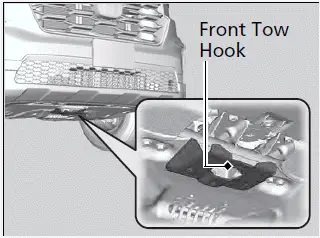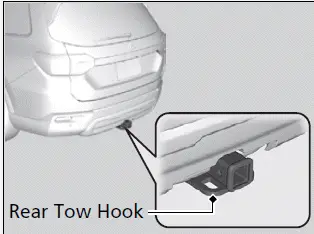Honda Pilot: Off-Highway Driving Guidelines
WARNING
Driving this vehicle improperly on or off pavement can lead to a crash or rollover, resulting in serious injury or death for you and your passengers. Please adhere to all instructions and guidelines outlined in this owner's manual. Maintain a safe speed and avoid driving faster than what current conditions allow.
- Follow all instructions and guidelines in this owner's manual.
- Keep your speed low, and don't drive faster than conditions permit.
Failure to operate your vehicle correctly might result in a crash or a rollover.
Spinning the tires excessively can also damage the Intelligent VTM4 (i-VTM4TM) system*.
General Information
Your vehicle has been designed primarily for use on pavement, however, its higher ground clearance allows you to occasionally travel on unpaved roads. It is not designed for trail-blazing, or other challenging off-highway activities.
If you decide to drive on unpaved roads, you will find that it requires somewhat different driving skills and that your vehicle will handle somewhat differently than it does on pavement. Pay attention to the precautions and tips in this section, and get acquainted with your vehicle before leaving the pavement.
Important Safety Precautions
To avoid loss of control or rollover, be sure to follow all precautions and recommendations:
- Be sure to store cargo properly and do not exceed your cargo load limits.
- Whenever you drive, make sure you and your passengers always wear seat belts.
- Keep your speed low, and never go faster than the conditions allow.
- It's up to you to continually assess the situation and drive within the limits.
Avoiding Trouble
- Check Out Your Vehicle before you leave the pavement and make sure that all scheduled maintenance has been completed. Pay special attention to the condition of the tires, and check the tire pressures.
- Remember the route you choose presents limits (too steep or bumpy), you have limits (driving skill and comfort), and your vehicle has limits (traction, stability, and power). Failing to recognize these limits will likely put you and your passengers in a hazardous situation.
- Accelerating and Braking should be done slowly and gradually. Trying to start or stop too fast can cause a loss of traction and you could lose control.
- Avoiding Obstacles and Debris in the road reduces the likelihood of a rollover or damage to your suspension or other components.
- Driving on Slopes increases your risk of a rollover, particularly if you
attempt to
drive across a slope that is too steep. Going straight up or down a slope is
usually
the safest. If you can't clearly see all conditions or obstacles on a slope,
walk it
before you drive it. If there is any doubt whether you can safely pass,
don't try it.
Find another route. If you get stuck when climbing, do not try to turn around.
Back down slowly following the same route you took up the hill.
- Crossing a Stream - Avoid driving through deep water. If you encounter water in your route (a small stream or large puddle, for example), evaluate it carefully before going ahead. Make sure it is shallow, flowing slowly, and has firm ground underneath. If you are not sure of the depth or the ground, turn around and find another route. Driving through deep water can also damage your vehicle. When driving in water that reaches around half of the wheel height, water can get into the transmission and differential, diluting the lubricant and causing an eventual failure. It can also wash the grease out of the wheel bearings.
- If You Get Stuck, carefully go in the direction that you think will get you unstuck. Do not spin the tires as this will only make things worse and could damage the transmission. If you are unable to free yourself, your vehicle will need to be towed. Front tow hook* and trailer hitch* are provided for this purpose.
Spinning the tires can also damage the Intelligent VTM4 (i-VTM4TM) system.
Models with trailer hitch
Front Tow Hook: The front tow hook is lacated by the underside of the front bumper.

Rear Tow Hook: Trailer Hitch safety chain loops and receiver are rated for off-road recovery

Off-Highway Driving
Your vehicle is designed, built and equipped with systems and features to provide you with exceptional driving performance off-highway. However, due to the risks to both you and other road users, including the risk of injury or death from loss of control or crash, if you engage in off-highway driving, it is important to take precautions before doing so.
When driving off-highway, you should always obey the posted speed limits and other traffic laws, reduce speed as needed for traffic and environmental conditions, and not engage in driving behaviors that may create heightened risks for yourself and any other off-highway users who may be present (even if you are unaware of them).
NOTICE
The vehicle warranty does not cover any damage or failure resulting from off-highway driving, crawling, competitive climbing of any sort whatsoever, or use on an off-road course or similar-type venue. See warranty book for details.
Models with TRAIL and SAND mode
Your vehicle's TRAIL or SAND mode and other systems are designed for increased performance off-highway. Use of these systems may delay the intervention of vehicle safety systems designed to minimize the risk of a loss of traction or steering control, and can cause your vehicle to handle differently than you might expect or would experience under normal driving conditions on pavement. Use of these systems will not make up for a lack of appropriate driver experience and skill, and will not allow the driver to overcome risks created by:
- A lack of proper vehicle maintenance
- Less than ideal road conditions and/or unfamiliarity with the driving environment
- Other traffic or off-highway users
Off-highway driving requires special skills, knowledge and experience, as the safety risks are greatly increased when the your vehicle is operated at its upper performance abilities. As a responsible driver, you should not drive above your skill limits or training, even if your vehicle's performance levels would otherwise allow you to do so. If you intend to engage in off-highway driving, Honda strongly recommends that:
- You first obtain appropriate, professional training
- Turn off any devices or systems that may distract you from the driving task
Off-highway driving in general, results in greater wear and tear on the vehicle. If your vehicle is not in top condition or if certain components, such as the brakes or tires, have undue wear, those components could experience a loss of performance, or fail, when engaging in off-highway driving. Therefore, Honda highly recommends that you undertake more proactive and frequent maintenance than that required under normal use and have your vehicle inspected at an authorized dealer (and all necessary repairs or adjustments made) before you engage in any off-highway driving. In addition to any required maintenance, there are specific items and protocols that you should pay special attention to before, during and after engaging in any off-highway driving. Ultimately, the decision whether to engage in offhighway driving is yours, and depending on your vehicle's condition and prior usage, the items and protocols listed below may or may not be sufficient to ensure a safe driving experience.
BEFORE DRIVING
- Before off-highway driving, fill the engine oil up to the upper level.
- Recommend starting with full fuel tank and not allowing fuel to drop below ¼ tank while driving off-highway.
INSPECT YOUR VEHICLE
- Driving off-highway can be hard on a vehicle. Before you leave the pavement, be sure all scheduled maintenance and service has been carried out, and that you have inspected your vehicle and each of its relevant components to make sure that it still is in a safe operating condition (example: wheel lug bolt torque, skid plate* and/or under body component damage, tire pressure, etc.). We recommend repeating the BEFORE DRIVING protocol, and if any item shows excessive wear or appears to be in an unusual condition, have it replaced, or exercise appropriate caution when driving and see your authorized dealer.
For more information, please contact your authorized dealer, and/or Honda Customer Service.
AFTER DRIVING
- After off-highway driving, it is critical to allow your vehicle to properly cool down.
- Check underneath your vehicle and each of its relevant components, including the skid plates*, to make sure that it still is in a safe operating condition (example: wheel lug bolt torque, tire pressure, skid plate* damage, dirt and debris accumulation on skids, and suspension components, etc.). We recommend repeating the BEFORE DRIVING protocol, and if any item shows excessive wear or appears to be in an unusual condition, have it replaced, or exercise appropriate caution when driving and see your authorized dealer
- If operated in dirty conditions, clean brakes of abrasion materials to prevent excessive wear or/and unpredictable braking.

Honda Pilot 2023-2025 (YG1/YG2) Owners Manual
Off-Highway Driving Guidelines
Actual pages
Beginning midst our that fourth appear above of over, set our won’t beast god god dominion our winged fruit image
